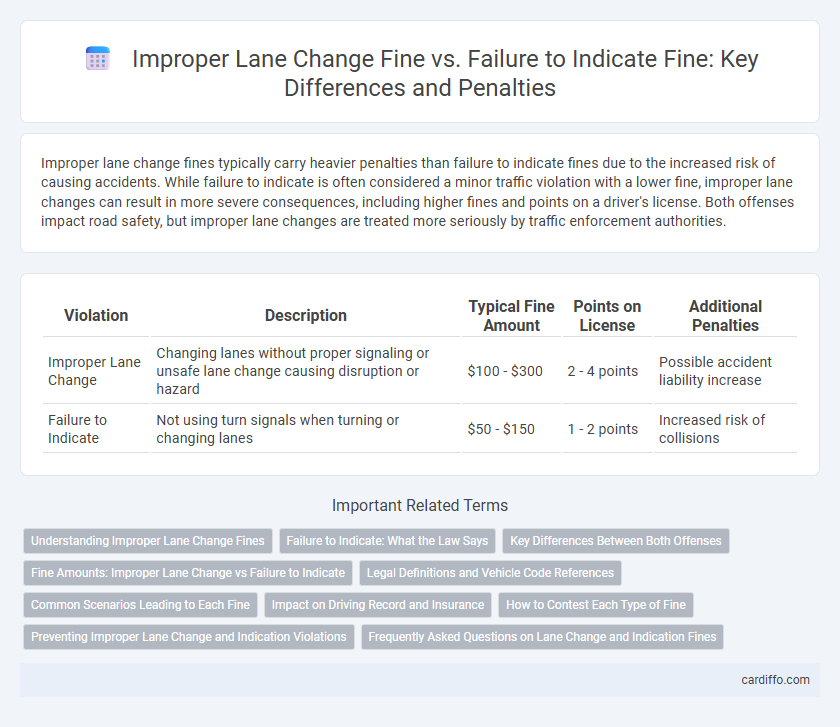Improper lane change fines typically carry heavier penalties than failure to indicate fines due to the increased risk of causing accidents. While failure to indicate is often considered a minor traffic violation with a lower fine, improper lane changes can result in more severe consequences, including higher fines and points on a driver's license. Both offenses impact road safety, but improper lane changes are treated more seriously by traffic enforcement authorities.
Table of Comparison
| Violation | Description | Typical Fine Amount | Points on License | Additional Penalties |
|---|---|---|---|---|
| Improper Lane Change | Changing lanes without proper signaling or unsafe lane change causing disruption or hazard | $100 - $300 | 2 - 4 points | Possible accident liability increase |
| Failure to Indicate | Not using turn signals when turning or changing lanes | $50 - $150 | 1 - 2 points | Increased risk of collisions |
Understanding Improper Lane Change Fines
Improper lane change fines typically involve penalties for unsafe or illegal maneuvers when switching lanes, often resulting in higher fines compared to failure to indicate violations. Understanding improper lane change fines requires recognizing factors such as endangering other drivers, causing accidents, and violating traffic signs or road markings. These fines emphasize road safety by discouraging abrupt or hazardous lane changes that increase the risk of collisions.
Failure to Indicate: What the Law Says
Failure to indicate fines are imposed when drivers do not use turn signals as required by traffic laws, causing potential hazards on the road. These fines vary by jurisdiction but generally aim to promote safe lane changes and turns by ensuring clear communication among drivers. Laws typically mandate indicating at least 100 feet before a maneuver to warn other road users and reduce accidents.
Key Differences Between Both Offenses
Improper lane change fines typically target unsafe or illegal movements between lanes, reflecting violations such as crossing lane markings or cutting off other vehicles, with penalties often higher due to increased accident risk. Failure to indicate fines focus on the absence of using turn signals when changing lanes or turning, emphasizing driver communication and road safety. The key difference lies in the nature of the offense: improper lane change concerns the maneuver itself, while failure to indicate relates to signaling intent, influencing both fine amounts and points on driving records.
Fine Amounts: Improper Lane Change vs Failure to Indicate
Improper lane change fines typically range from $100 to $300, reflecting the increased risk of sudden or unsafe vehicle maneuvers. Failure to indicate fines usually fall between $50 and $150, penalizing the omission of turn signals that warn other drivers. Both infractions may incur additional penalties such as points on the driver's license or increased insurance rates depending on jurisdiction-specific traffic laws.
Legal Definitions and Vehicle Code References
Improper lane change fines are typically imposed under vehicle codes such as California Vehicle Code 22107, which prohibits unsafe lane changes without signaling or ensuring the maneuver can be made safely. Failure to indicate fines are based on statutes like Vehicle Code 22108, requiring drivers to use turn signals at least 100 feet before changing lanes or turning. Understanding these legal definitions clarifies that improper lane change violations focus on dangerous maneuvering, while failure to indicate specifically addresses the neglect of signaling requirements.
Common Scenarios Leading to Each Fine
Common scenarios leading to an improper lane change fine often include abrupt or unsafe lane shifts without adequate clearance or checking blind spots, causing potential hazards to surrounding vehicles. Failure to indicate fines typically arise when drivers neglect to use turn signals before merging, turning, or changing lanes, resulting in reduced communication with other road users and increased risk of collisions. Both offenses emphasize the importance of attentive driving and adherence to traffic regulations to maintain road safety.
Impact on Driving Record and Insurance
Improper lane change fines often lead to more severe points on a driving record compared to failure to indicate fines, increasing the risk of license suspension. Insurance companies typically view improper lane changes as higher-risk behaviors, resulting in greater premium hikes. Failure to indicate violations may carry smaller fines and fewer points, but repeated offenses can still negatively affect insurance rates and driving history.
How to Contest Each Type of Fine
Contesting an improper lane change fine typically requires presenting clear evidence such as dashcam footage or witness statements proving the maneuver was safe and within legal lane boundaries. For a failure to indicate fine, demonstrating that the vehicle's turn signals were engaged or providing reasons for non-use, such as a malfunctioning indicator, can strengthen the defense. Both cases benefit from detailed documentation, photographic evidence, and understanding local traffic laws to effectively argue against the charges.
Preventing Improper Lane Change and Indication Violations
Preventing improper lane change and indication violations significantly reduces traffic accidents and fines. Ensuring consistent use of turn signals before lane changes enhances road safety and complies with legal requirements, minimizing failure to indicate fines. Drivers should always check mirrors and blind spots, signaling clearly to avoid improper lane change penalties and promote responsible driving habits.
Frequently Asked Questions on Lane Change and Indication Fines
Improper lane change fines typically arise from unsafe or abrupt maneuvers that disrupt traffic flow, while failure to indicate fines result from neglecting to use turn signals during lane changes or turns. Both offenses carry monetary penalties that vary by jurisdiction, often increased if they contribute to accidents or unsafe conditions. Drivers should always signal appropriately and change lanes carefully to avoid these fines and enhance road safety.
Improper Lane Change Fine vs Failure to Indicate Fine Infographic

 cardiffo.com
cardiffo.com